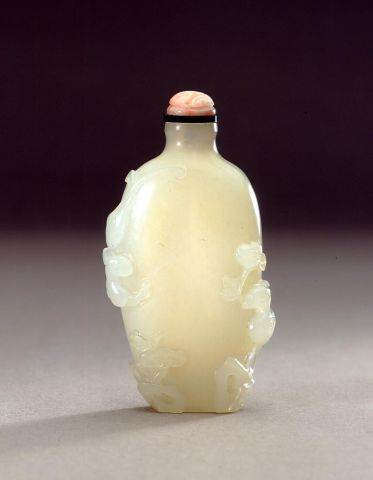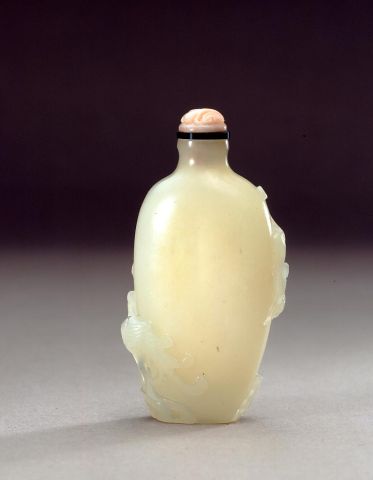


Bottle ID: 206
IMPERIAL, CARVED WITH DRAGON AND PHOENIX
Date: 1740-1799
Height: 58 mm
Nephrite, white, of slender elongated form, well hollowed and with shoulders sloping to a waisted neck and wide mouth with straightened lip, the base with a recessed oval foot, carved along one shoulder and narrow side with a Qilong above rockwork and lingzhi fungus; the other narrow side of the bottle with a phoenix standing on rockwork with a peony bud in its beak.
Imperial, attributed to the Palace Workshops, Beijing.
Similar Examples:
Sotheby's, London, March 23, 1988, lot 187.
Sotheby's, New York, September 14, 2010, lot 74, The Joe Grimberg Collection.
Provenance:
Clare Lawrence Ltd.
Phillip's, London, December 8, 1993
Exhibited:
Annual Convention ICSBS New York, November 2013
Published:
JICSBS, Autumn 2013, Front Cover
Given that after 1760 the Palace had an increased supply of jade it is likely that at this time the carvers of Suzhou would also have had access to a proportional increase in the commercial jade supply. This expansion accelerated the production of wares for the Palace both in the Imperial workshops and in Suzhou itself. The Zaobanchu, the administrative office which controlled the Palace workshops provided a system which dictated to them pre-ordained designs and orders for the pieces. The influential minority who had the responsibility passed to them for ordering the pieces would have had little tolerance of the creativity of the craftsmen, merely utilizing their skills to produce what was required. The output in this sense is anonymous as the piece may have no mark on it or solely the reign mark of the ruling emperor. Even given the facts that pieces were made elsewhere and allowing for the cross-fertilization of ideas due to the movement of workers, a palace style would have been quickly imposed upon craftsmen. It is likely that these carvers could turn themselves to a wide range of materials so that a jade carver would have undoubtedly carved in stones, such as agate, and perhaps even glass.
< Back to full list

 English
English 中文
中文